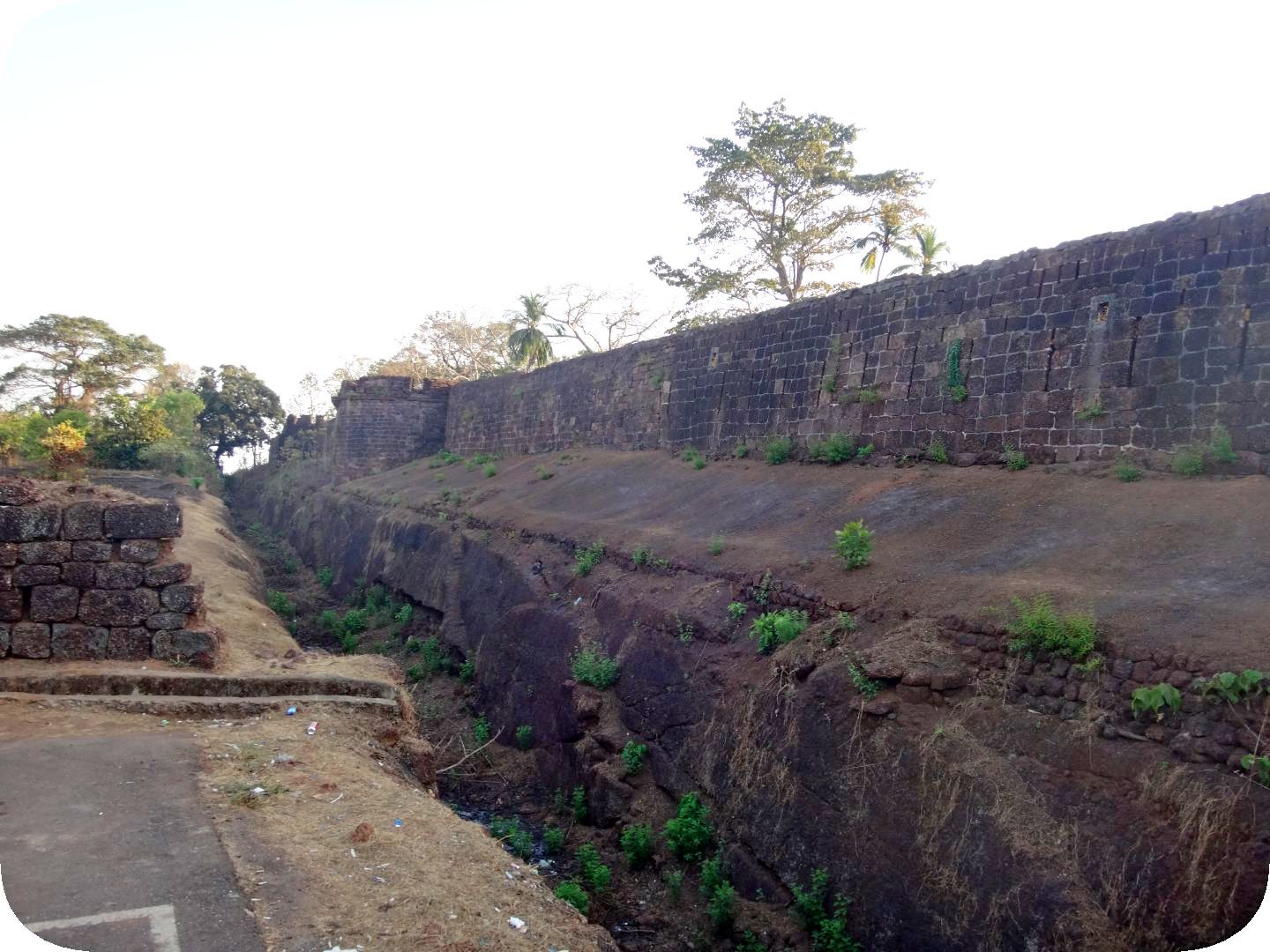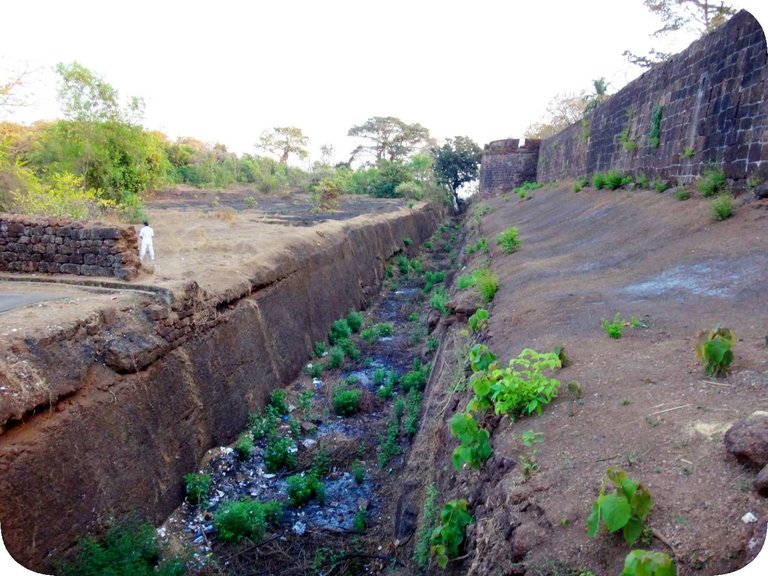Excursion to the Fort Cabo de Rama. part 10\Ausflug zu Fort Cabo de Rama. Teil 10
HELLO!
The ditch at the entrance to the fortress is littered with garbage, perhaps sometimes it is cleaned, yet the ditch is not filled to the brim with garbage. But garbage is the scourge of the entire planet, not just India. Hand on heart, in our yards now there is no less garbage than in Goa. Although Goa is a demonstratively cleaned (adjusted for Indian laziness) state, there is enough garbage there.
The best part is that the entrance to the fort is free! Maybe that's why he is so broken-down, there is no incentive to restore it. Oh yes, why do the cape and the fort on it bear the name of Rama, and not, for example, Don Pereira? If anyone does not remember, then Rama is the 7th avatar of the god Vishnu. Rama and Krishna are the most popular avatars of Vishnu. And Sita is an avatar of Lakshmi and a perfect woman in combination! Many Hindus believe that Rama, the hero of the Ramayana epic, is a real-life historical character, concurrently the king of Koshala. The thing is that it was allegedly in these parts that Rama and his beloved wife Sita hid during the time of exile from Ayodhya, the capital of the kingdom of Koshala. Family squabbles, a matter of honor and all that. Therefore, Rama and Sita voluntarily went into exile. And Rama's brother Lakshmana also left with them. And they lived here for 14 years.
A few details about the family showdown. Once upon a time there was a king Dasaratha (“Hero of 10 chariots”) and he had 3 wives: Kaushalya, Kaikeyi and Sumitra. There were no children from the first two wives, and therefore the king also had a third wife, but in vain, apparently, it was not about the wives there. Only after the sacrifice of the yajna did the matter of reproduction go smoothly. The bellies of the wives noticeably rounded. The sage Vasistha gave names to the children, well, it is not for parents to entrust such an important matter. Kausalya's child was named Rama, Kaikeyi's child was Bharata, and Sumitra's twins were named Lakshmana and Shatrughna. It so happened that during the war with the asura Samhasura, Kaikeyi saved Dasaratha, who was wounded by an arrow, from death. Grateful Dasaratha promised to fulfill any two wishes of his wife. Which she then used. By all accounts, the eldest son of Rama was supposed to inherit the throne of his father, but Kaikeyi demanded to put her son Bharata on the throne, and drive Rama and his wife into the forest, for 14 years. Both desires came in handy. Good woman, she could
demand exile forever or even the death penalty. The king has nowhere to go, he gave his word, be strong. Dasaratha kicked out his son, and he himself was mortally bored from his crime and died from the longing of separation. Died after 6 days! Well, the hermit Shravana, who cursed Dasharatha, is still a little to blame.
There were interesting times. People knew how to have fun in the era without the Internet. This is not for you to like cats!
What happens next is a truly strange story. Almost like the story of Bahubali and the other Bharat that I wrote about here. During these events, Bharata was visiting “in the village with his grandfather”, then he joyfully arrived in the capital of Ayodhya, and everyone there was somehow sad. Bharata turned out to be a very decent young man and told his mother that he would not take the throne, because it belongs to Rama, and Kaikeyu simultaneously blamed his father for the death and stated that she was no longer his mother and he no longer wanted to know her. The poor woman died alone, forgotten by everyone. Here is such a grateful reward for a son's career, children sometimes do not appreciate the efforts of their parents. Now you understand where such seething passions come from in Indian films? Yes, there you can safely film the “Ramayana”, there will be enough atrocities and heart-rending stories for everyone!
Bharata formally accepted the throne, and he took off his slippers and went barefoot to look for Rama, taking with him some of the inhabitants of the glorious Ayodhya. Rama refused to take the throne, and Bharata decided not to waste time in vain and walked around the bush for a week for tourist purposes, climbing all the waterfalls and lakes along with Shatrughna.
Rama was imbued with his brother's tourist exploits, especially since he brought a crowd of clients with him, normally raised the tourism business in Goa, and gave him his slippers as a symbol that one day Rama would return home. Slippers were placed on the throne in the capital, and the locals were ecstatic with happiness. Bharata handed over the reins of government to Sumitra and Kaushalya, and he himself went to the forest hut to practice yoga. Point your finger at someone who would do the same today! And later, Rama will deal with his personal affairs, along the way hitting the popular demon Ravana in the face (Ravana bothered even Shiva himself, he was still a brave man and chlamon) returned to the throne and became king, and then, like the emperor of the whole world. Rules of some ridiculous 11 thousand years ...
..to be continued…
●
Der Graben am Eingang der Festung ist mit Müll übersät, vielleicht wird er manchmal gereinigt, aber der Graben ist nicht bis zum Rand mit Müll gefüllt. Aber Müll ist die Geißel des gesamten Planeten, nicht nur Indiens. Hand aufs Herz, auf unseren Höfen liegt jetzt nicht weniger Müll als in Goa. Obwohl Goa ein aufschlussreicher (um indische Faulheit bereinigter) Zustand ist, gibt es dort genug Müll.
Das Beste daran ist, dass der Eintritt in die Festung kostenlos ist! Vielleicht ist er deshalb so kaputt, es gibt keinen Anreiz, ihn wiederherzustellen. Ach ja, warum tragen der Umhang und das Fort darauf den Namen Rama und nicht zum Beispiel Don Pereira? Wenn sich jemand nicht erinnert, dann ist Rama der 7. Avatar des Gottes Vishnu. Rama und Krishna sind die beliebtesten Avatare von Vishnu. Und Sita ist ein Avatar von Lakshmi und eine perfekte Frau in Kombination! Viele Hindus glauben, dass Rama, der Held des Ramayana-Epos, eine reale historische Figur ist, gleichzeitig der König von Koshala. Die Sache ist die, dass Rama und seine geliebte Frau Sita sich angeblich in diesen Gegenden während ihres Exils aus Ayodhya, der Hauptstadt des Königreichs Koshala, versteckten. Familienstreit, Ehrensache und so. Deshalb gingen Rama und Sita freiwillig ins Exil. Und Ramas Bruder Lakshmana ging auch mit ihnen. Und sie lebten hier 14 Jahre lang.
Ein paar Details zum Familien-Showdown. Es war einmal ein König Dasaratha („Held der 10 Streitwagen“) und er hatte 3 Frauen: Kaushalya, Kaikeyi und Sumitra. Es gab keine Kinder von den ersten beiden Frauen, und deshalb hatte der König auch eine dritte Frau, aber vergebens, anscheinend ging es dort nicht um die Frauen. Erst nach dem Opfer des Yajna verlief die Fortpflanzung reibungslos. Die Bäuche der Ehefrauen merklich gerundet. Der Weise Vasistha gab den Kindern Namen, nun, es ist nicht Sache der Eltern, eine so wichtige Angelegenheit anzuvertrauen. Kausalyas Kind hieß Rama, Kaikeyis Kind hieß Bharata und Sumitras Zwillinge hießen Lakshmana und Shatrughna. So geschah es, dass Kaikeyi während des Krieges mit dem Asura Samhasura Dasharatha, die von einem Pfeil verwundet wurde, vor dem Tod rettete. Der dankbare Dasharatha versprach, alle zwei Wünsche seiner Frau zu erfüllen. Was sie dann benutzte. Allen Berichten zufolge sollte der älteste Sohn von Rama den Thron seines Vaters erben, aber Kaikeyi verlangte, ihren Sohn Bharata auf den Thron zu setzen und Rama und seine Frau für 14 Jahre in den Wald zu treiben . Gute Frau, sie konnte
fordern ewiges Exil oder gar die Todesstrafe. Der König kann nirgendwo hingehen, er hat sein Wort gegeben, sei stark. Dasharatha warf seinen Sohn hinaus, und er selbst war von seinem Verbrechen tödlich gelangweilt und starb an der Sehnsucht nach Trennung. Nach 6 Tagen gestorben! Nun, der Einsiedler Shravana, der Dasharatha verfluchte, ist immer noch ein wenig schuld.
Es waren interessante Zeiten. Die Leute wussten, wie man sich in Zeiten ohne Internet amüsiert. Das ist nichts für Sie, um Katzen zu mögen!
Was als nächstes passiert, ist eine wirklich seltsame Geschichte. Fast wie die Geschichte von Bahubali und den anderen Bharat, über die ich hier geschrieben habe. Bharata besuchte während dieser Ereignisse „seinen Großvater im Dorf“, dann kam er freudig in der Hauptstadt Ayodhya an, und dort waren alle irgendwie traurig. Bharata stellte sich als sehr anständiger junger Mann heraus und sagte seiner Mutter, dass er den Thron nicht besteigen würde, weil er Rama gehöre, und Kaikeyu machte gleichzeitig seinen Vater für den Tod verantwortlich und erklärte, dass sie nicht mehr seine Mutter sei und er nicht mehr wollte sie kennenlernen. Die arme Frau starb allein, von allen vergessen. Hier ist eine so dankbare Belohnung für die Karriere eines Sohnes, dass Kinder die Bemühungen ihrer Eltern manchmal nicht zu schätzen wissen. Verstehst du jetzt, woher solche brodelnden Leidenschaften in indischen Filmen kommen? Ja, dort können Sie das „Ramayana“ sicher filmen, es wird genug Gräueltaten und herzzerreißende Geschichten für alle geben!
Bharata nahm formell den Thron an, und er selbst zog seine Pantoffeln aus und ging barfuß, um nach Rama zu suchen, wobei er einige der Bewohner des glorreichen Ayodhya mit sich nahm. Rama weigerte sich, den Thron zu besteigen, und Bharata beschloss, keine Zeit umsonst zu verschwenden, und wanderte zu touristischen Zwecken eine Woche lang durch den Busch und erklomm alle Wasserfälle und Seen zusammen mit Shatrughna.
Rama war von den touristischen Heldentaten seines Bruders durchdrungen, zumal er eine Menge Kunden mitbrachte, normalerweise das Tourismusgeschäft in Goa aufbaute und ihm seine Pantoffeln als Symbol dafür gab, dass Rama eines Tages nach Hause zurückkehren würde. In der Hauptstadt wurden Hausschuhe auf den Thron gestellt, und die Einheimischen waren vor Glück verzückt. Bharata übergab die Regierungsgeschäfte an Sumitra und Kaushalya, und er selbst ging in die Waldhütte, um Yoga zu praktizieren. Zeigen Sie mit dem Finger auf jemanden, der heute dasselbe tun würde! Und später wird Rama sich um seine persönlichen Angelegenheiten kümmern und gleichzeitig dem beliebten Dämon Ravana ins Gesicht schlagen (Ravana störte sogar Shiva selbst, er war immer noch ein tapferer Mann und ein Chlamon), kehrte auf den Thron zurück und wurde König und dann wie der Kaiser der ganzen Welt. Regeln von einigen lächerlichen 11.000 Jahren ...
..Fortsetzung folgt…
●




Congratulations @duremarr! You received a personal badge!
You can view your badges on your board and compare yourself to others in the Ranking
Check out the last post from @hivebuzz:
Support the HiveBuzz project. Vote for our proposal!